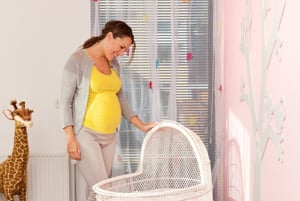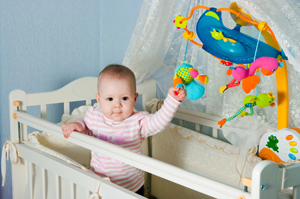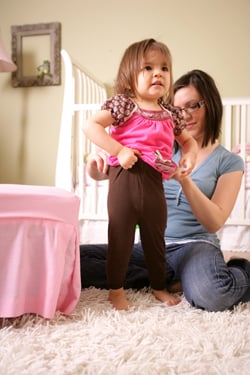Baby bedding recommendation
Newborn babies aren’t really particular about where they sleep and, if given the choice, would probably stay in their parents’ arms all day. Many are pretty successful too! The most common and safest place for a new baby to sleep is in a bassinette, cradle or cot. Whichever you use, ensure it meets SABS approval.

Prams, carry-cots or folding cots, hammocks, swings, rocker chairs and strollers are not safe places for babies to sleep. They don’t provide enough support for any reasonable length of time, and are only designed to be temporary, short-term options. Because of a newborn’s size, some parents feel their baby “gets lost” in a big cot. But whether you choose to use a bassinette or place your baby in a cot from birth is really up to you.
If there is an older toddler already using the family cot, it may just be more practical to use a bassinette for the first few months. If you are borrowing a bassinette or a cot, again, make sure it meets SABS approval.
Some parents have very firm views on putting their baby into their own room from birth. But separating young babies from their parents is not a good idea, and experts say the best place for babies to sleep is in the parent’s room. The current recommendations are for babies to sleep in their own safe sleeping environment (bassinette or cot) beside the parent’s bed for the first 6-12 months of life.
Types of cots:

Cots have not always been safe places for babies to sleep. Our understanding of the risks, and potential for harm to babies and children from nursery furniture, is better than it has ever been. Babies do not have the cognitive ability to determine what is safe and what could hurt them. As parents, a major part of our role is to create environments that do not compromise our children’s potential to grow to adulthood.
Any new cot has to meet strict regulations governing its manufacture, workmanship, materials and dimensions. However, there aren’t regulations of safety on any of the following:
- Folding-or carry-cots
- Bassinettes or rocking cradles
- Toddler beds or smaller beds that are not a uniform single bed size
- Antique or decorative cots
Points to consider when buying a cot:
- Make sure the cot is going to fit into the space you have for it. Does the cot disassemble, is it easy to put up, how durable is it, and how easy is it to lower the sides? Does it have good working catches and a sturdy frame?
- Check for a snug-fitting mattress that does not leave any gaps between the vertical rails and the mattress. If you are buying a mattress separately, ensure there is no more than a 20 mm (2 cm) gap between the side of the mattress and the cot sides or ends.
- The cot needs safe edges and nothing that could be used as a foothold. Smooth, rounded corners minimise the risks of loops of clothing being caught around them.
Note: Make sure you don’t position the cot near blind cords or power points. Babies are very inquisitive and can reach to grab anything that looks even vaguely interesting.
When is it time for a bed?
The age a child moves out of the cot is, again, up to their parents and what suits the household.

- Generally, cots are ideal until around 2 years of age when most children become too big for them. Often, a new baby coming into the family is the prompt for the older child to move on and start sleeping in their own bed.
- Excitable toddlers less than 2 years of age can be difficult to persuade to stay on their bed, calm down and then go off to sleep. The benefit of cots is that they contain active toddlers. There comes a time when they need to move on though.
- A simple but effective guide for when to graduate to a bed is when the top horizontal rail is in alignment with the child’s chest. By then they are tall enough to lever themselves up and over the rail, because this is where their centre of gravity (balance point) is.
- Some parents gradually transition their toddler out of the cot and into a bed. Day sleeps provide an ideal time for introducing a bed, while still using the cot for night sleeps. Over a week or so, the change is not as sudden.
- Positioning bed rails on the child’s bed, or placing a mattress on the floor, helps to prevent injury in the case of falling out of bed.
Comfort measures:
Babies tend to sleep better in cooler, darker environments. Even during the day, it can be useful to darken the room your baby is sleeping in. Curtains or blinds are often effective, though are not always possible. You can try some of the following:
- If you want to de-sensitise your baby to ambient noise, don’t be too careful about being quiet. Some white noise from kitchen appliances, a CD or radio playing, or leaving the door ajar, can all be effective. Families are naturally noisy and you cannot filter out your baby’s environment completely.
- Make sure your baby is warm, though not overdressed, when they go to sleep. Comfort measures, such as changing them into clean, comfortable clothing, socks on their feet (if it’s cold), changing their diaper, and making sure the sheets are smooth under their head may seem trivial but make a big difference.
- Lots of babies like to suck when they go to sleep. Dummies are a fact of life for many. Unless your baby is waking up multiple times for you to help them find their dummy and put it back in their mouth, just accept that it is fulfilling a short-term purpose for you both.
- If you are unsure whether your baby is cold, feel their skin temperature on their chest. If you are cold, chances are your baby is as well. Dress your baby as you are dressed yourself, to be comfortable for whatever the weather is.
- Babies who have developed a flat area on the back of their heads (plagiocephaly), benefit from having their cot moved to a different position in the room. This encourages them to lie in a different way which relieves continual pressure on the same area of their skull. Another option is to place them at alternate ends of the cot so they don’t always need to be looking out the same way.
Sleeping bags:
There have become popular recently, especially during the cooler winter months.
- Look for a sleeping bag that has a fitted neck and armholes and sleeves and, importantly, no hood. Make sure your baby cannot slide down into the sleeping bag. Don’t use additional blankets or duvets because of the risk of overheating.
- Sleeping bags are thought to be protective against SIDS (Sudden Infant Death Syndrome) or SUDI (Sudden Unexplained Death in Infancy) because they delay the baby rolling onto their tummy. The safest position for a baby to sleep is on their back, never on their tummy or sides.
- Dress your baby in comfortable layers of clothing underneath the sleeping bag.
- Using a sleeping bag will prevent bedclothes covering your baby’s face. Babies control their temperatures through their face and it’s very important to keep their head and face uncovered, to avoid them becoming overheated.

